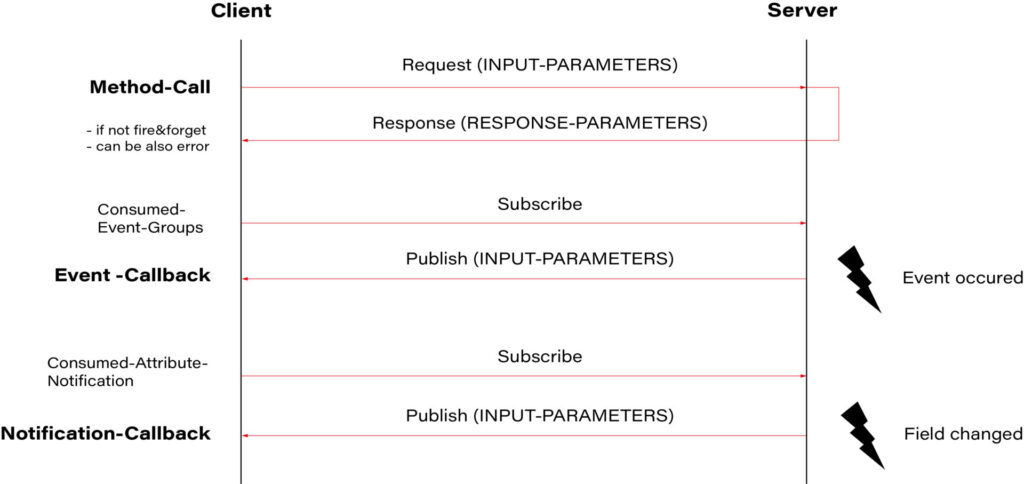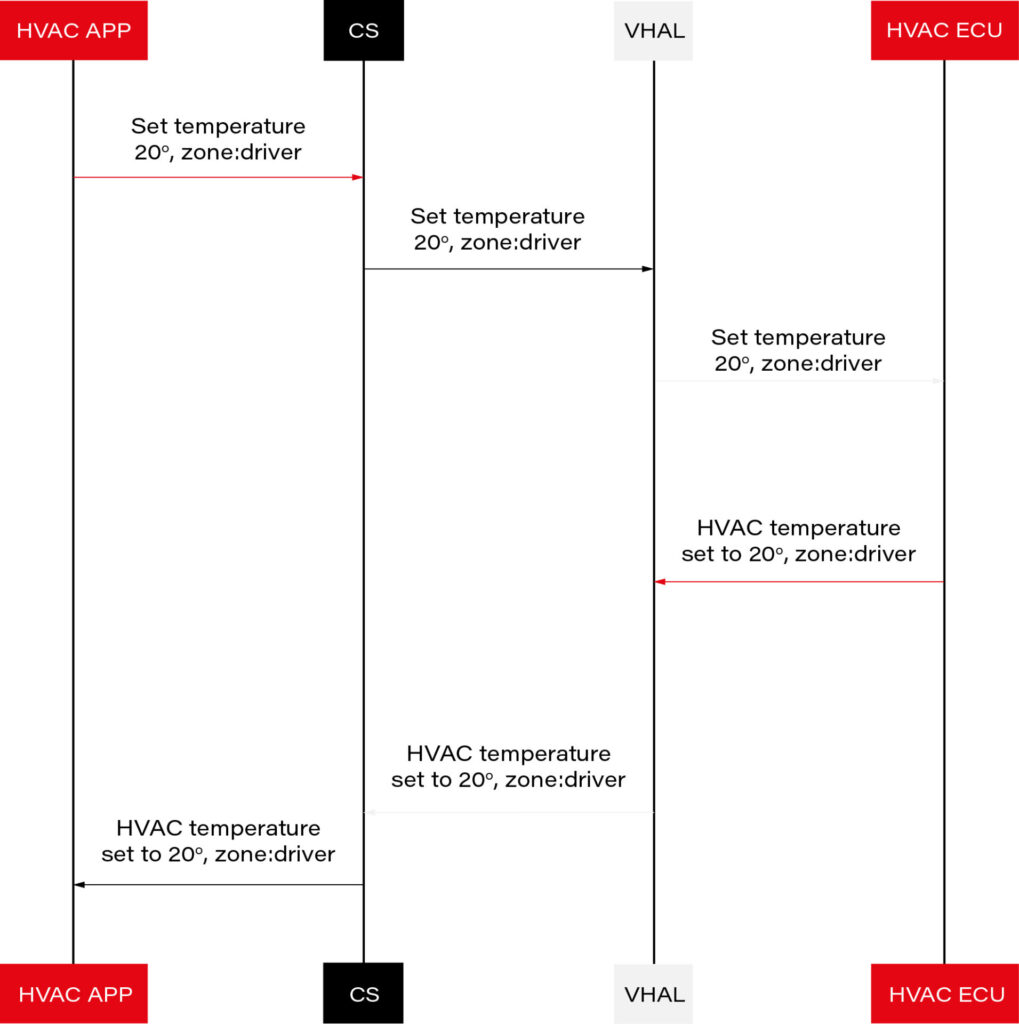Controlling HVAC Module in Cars Using Android: A Dive into SOME/IP Integration

In modern automotive design, controlling various components of a vehicle via mobile devices has become a significant trend, enhancing user experience and convenience. One such component is the HVAC (Heating, Ventilation, and Air Conditioning) system, which plays a crucial role in ensuring passenger comfort. In this article, we’ll explore how to control the HVAC module in a car using an Android device, leveraging the power of the SOME/IP protocol.
Understanding HVAC
HVAC stands for Heating, Ventilation, and Air Conditioning. In the context of automotive engineering, the HVAC system regulates the temperature, humidity, and air quality within the vehicle cabin. It includes components such as heaters, air conditioners, fans, and air filters. Controlling the HVAC system efficiently contributes to passenger comfort and safety during the journey.
Introduction to SOME/IP
In the SOME/IP paradigm, communication is structured around services, which encapsulate specific functionalities or data exchanges. There are two main roles within the service-oriented model:
Provider: The provider is responsible for offering services to other ECUs within the network. In the automotive context, a provider ECU might control physical actuators, read sensor data, or perform other tasks related to vehicle operation. For example, in our case, the provider would be an application running on a domain controller within the vehicle.
The provider offers services by exposing interfaces that define the methods or data structures available for interaction. These interfaces can include operations to control actuators (e.g., HVAC settings) or methods to read sensor data (e.g., temperature, humidity).
Consumer: The consumer, on the other hand, is an ECU that utilizes services provided by other ECUs within the network. Consumers can subscribe to specific services offered by providers to receive updates or invoke methods as needed. In the automotive context, a consumer might be responsible for interpreting sensor data, sending control commands, or performing other tasks based on received information.
Consumers subscribe to services they are interested in and receive updates whenever there is new data available. They can also invoke methods provided by the service provider to trigger actions or control functionalities. In our scenario, the consumer would be an application running on the Android VHAL (Vehicle Hardware Abstraction Layer), responsible for interacting with the vehicle’s network and controlling HVAC settings.
SOME/IP Communication Flow
The communication flow in SOME/IP follows a publish-subscribe pattern, where providers publish data or services, and consumers subscribe to them to receive updates or invoke methods. This asynchronous communication model allows for efficient and flexible interaction between ECUs within the network.

Source: https://github.com/COVESA/vsomeip/wiki/vsomeip-in-10-minutes
In our case, the application running on the domain controller (provider) would publish sensor data such as temperature, humidity, and HVAC status. Subscribed consumers, such as the VHAL application on Android, would receive these updates and could send control commands back to the domain controller to adjust HVAC settings based on user input.
Leveraging VHAL in Android for Vehicle Networking
To communicate with the vehicle’s network, Android provides the Vehicle Hardware Abstraction Layer (VHAL). VHAL acts as a bridge between the Android operating system and the vehicle’s onboard systems, enabling seamless integration of Android devices with the car’s functionalities. VHAL abstracts the complexities of vehicle networking protocols, allowing developers to focus on implementing features such as HVAC control without worrying about low-level communication details.

Source: https://source.android.com/docs/automotive/vhal/previous/properties
Implementing SOMEIP Consumer in VHAL
To integrate a SOMEIP consumer into VHAL on Android 14, we will use the vsomeip library. Below are the steps required to implement this solution:
Cloning the vsomeip Repository
Go to the main directory of your Android project and create a new directory named external/sdv:
mkdir -p external/sdv
cd external/sdv
git clone https://android.googlesource.com/platform/external/sdv/vsomeip
Implementing SOMEIP Consumer in VHAL
In the hardware/interfaces/automotive/vehicle/2.0/default directory, you can find the VHAL application code. In the VehicleService.cpp file, you will find the default VHAL implementation.
int main(int /* argc */, char* /* argv */ []) {
auto store = std::make_unique<VehiclePropertyStore>();
auto connector = std::make_unique<DefaultVehicleConnector>();
auto hal = std::make_unique<DefaultVehicleHal>(store.get(), connector.get());
auto service = android::sp<VehicleHalManager>::make(hal.get());
connector->setValuePool(hal->getValuePool());
android::hardware::configureRpcThreadpool(4, true /* callerWillJoin */);
ALOGI("Registering as service...");
android::status_t status = service->registerAsService();
if (status != android::OK) {
ALOGE("Unable to register vehicle service (%d)", status);
return 1;
}
ALOGI("Ready");
android::hardware::joinRpcThreadpool();
return 0;
}
The default implementation of VHAL is provided in DefaultVehicleHal which we need to replace in VehicleService.cpp.
From:
auto hal = std::make_unique<DefaultVehicleHal>(store.get(), connector.get());To:
auto hal = std::make_unique<VendorVehicleHal>(store.get(), connector.get());For our implementation, we will create a class called VendorVehicleHal and inherit from the DefaultVehicleHal class. We will override the set and get functions.
class VendorVehicleHal : public DefaultVehicleHal {
public:
VendorVehicleHal(VehiclePropertyStore* propStore, VehicleHalClient* client);
VehiclePropValuePtr get(const VehiclePropValue& requestedPropValue,
StatusCode* outStatus) override;
StatusCode set(const VehiclePropValue& propValue) override;
};The get function is invoked when the Android system requests information from VHAL, and set when it wants to set it. Data is transmitted in a VehiclePropValue object defined in hardware/interfaces/automotive/vehicle/2.0/types.hal.
It contains a variable, prop, which is the identifier of our property. The list of all properties can be found in the types.hal file.
We will filter out only the values of interest and redirect the rest to the default implementation.
StatusCode VendorVehicleHal::set(const VehiclePropValue& propValue) {
ALOGD("VendorVehicleHal::set propId: 0x%x areaID: 0x%x", propValue.prop, propValue.areaId);
switch(propValue.prop)
{
case (int)VehicleProperty::HVAC_FAN_SPEED :
break;
case (int)VehicleProperty::HVAC_FAN_DIRECTION :
break;
case (int)VehicleProperty::HVAC_TEMPERATURE_CURRENT :
break;
case (int)VehicleProperty::HVAC_TEMPERATURE_SET:
break;
case (int)VehicleProperty::HVAC_DEFROSTER :
break;
case (int)VehicleProperty::HVAC_AC_ON :
break;
case (int)VehicleProperty::HVAC_MAX_AC_ON :
break;
case (int)VehicleProperty::HVAC_MAX_DEFROST_ON :
break;
case (int)VehicleProperty::EVS_SERVICE_REQUEST :
break;
case (int)VehicleProperty::HVAC_TEMPERATURE_DISPLAY_UNITS :
break;
}
return DefaultVehicleHal::set(propValue);
}Now we need to create a SOME/IP service consumer. If you’re not familiar with the SOME/IP protocol or the vsomeip library, I recommend reading the guide “vsomeip in 10 minutes”.
It provides a step-by-step description of how to create a provider and consumer for SOME/IP.
In our example, we’ll create a class called ZoneHVACService and define SOME/IP service, instance, method, and event IDs:
#define ZONE_HVAC_SERVICE_ID 0x4002
#define ZONE_HVAC_INSTANCE_ID 0x0001
#define ZONE_HVAC_SET_TEMPERATURE_ID 0x1011
#define ZONE_HVAC_SET_FANSPEED_ID 0x1012
#define ZONE_HVAC_SET_AIR_DISTRIBUTION_ID 0x1013
#define ZONE_HVAC_TEMPERATURE_EVENT_ID 0x2011
#define ZONE_HVAC_FANSPEED_EVENT_ID 0x2012
#define ZONE_HVAC_AIR_DISTRIBUTION_EVENT_ID 0x2013
#define ZONE_HVAC_EVENT_GROUP_ID 0x3011
class ZoneHVACService {
public:
ZoneHVACService(bool _use_tcp) :
app_(vsomeip::runtime::get()->create_application(vsomeipAppName)), use_tcp_(
_use_tcp) {
}
bool init() {
if (!app_->init()) {
LOG(ERROR) << "[SOMEIP] " << __func__ << "Couldn't initialize application";
return false;
}
app_->register_state_handler(
std::bind(&ZoneHVACService::on_state, this,
std::placeholders::_1));
app_->register_message_handler(
ZONE_HVAC_SERVICE_ID, ZONE_HVAC_INSTANCE_ID, vsomeip::ANY_METHOD,
std::bind(&ZoneHVACService::on_message, this,
std::placeholders::_1));
app_->register_availability_handler(ZONE_HVAC_SERVICE_ID, ZONE_HVAC_INSTANCE_ID,
std::bind(&ZoneHVACService::on_availability,
this,
std::placeholders::_1, std::placeholders::_2, std::placeholders::_3));
std::set<vsomeip::eventgroup_t> its_groups;
its_groups.insert(ZONE_HVAC_EVENT_GROUP_ID);
app_->request_event(
ZONE_HVAC_SERVICE_ID,
ZONE_HVAC_INSTANCE_ID,
ZONE_HVAC_TEMPERATURE_EVENT_ID,
its_groups,
vsomeip::event_type_e::ET_FIELD);
app_->request_event(
ZONE_HVAC_SERVICE_ID,
ZONE_HVAC_INSTANCE_ID,
ZONE_HVAC_FANSPEED_EVENT_ID,
its_groups,
vsomeip::event_type_e::ET_FIELD);
app_->request_event(
ZONE_HVAC_SERVICE_ID,
ZONE_HVAC_INSTANCE_ID,
ZONE_HVAC_AIR_DISTRIBUTION_EVENT_ID,
its_groups,
vsomeip::event_type_e::ET_FIELD);
app_->subscribe(ZONE_HVAC_SERVICE_ID, ZONE_HVAC_INSTANCE_ID, ZONE_HVAC_EVENT_GROUP_ID);
return true;
}
void send_temp(std::string temp)
{
LOG(INFO) << "[SOMEIP] " << __func__ << " temp: " << temp;
std::shared_ptr< vsomeip::message > request;
request = vsomeip::runtime::get()->create_request();
request->set_service(ZONE_HVAC_SERVICE_ID);
request->set_instance(ZONE_HVAC_INSTANCE_ID);
request->set_method(ZONE_HVAC_SET_TEMPERATURE_ID);
std::shared_ptr< vsomeip::payload > its_payload = vsomeip::runtime::get()->create_payload();
its_payload->set_data((const vsomeip_v3::byte_t *)temp.data(), temp.size());
request->set_payload(its_payload);
app_->send(request);
}
void send_fanspeed(uint8_t speed)
{
LOG(INFO) << "[SOMEIP] " << __func__ << " speed: " << (int)speed;
std::shared_ptr< vsomeip::message > request;
request = vsomeip::runtime::get()->create_request();
request->set_service(ZONE_HVAC_SERVICE_ID);
request->set_instance(ZONE_HVAC_INSTANCE_ID);
request->set_method(ZONE_HVAC_SET_FANSPEED_ID);
std::shared_ptr< vsomeip::payload > its_payload = vsomeip::runtime::get()->create_payload();
its_payload->set_data(&speed, 1U);
request->set_payload(its_payload);
app_->send(request);
}
void start() {
app_->start();
}
void on_state(vsomeip::state_type_e _state) {
if (_state == vsomeip::state_type_e::ST_REGISTERED) {
app_->request_service(ZONE_HVAC_SERVICE_ID, ZONE_HVAC_INSTANCE_ID);
}
}
void on_availability(vsomeip::service_t _service, vsomeip::instance_t _instance, bool _is_available) {
LOG(INFO) << "[SOMEIP] " << __func__ << "Service ["
<< std::setw(4) << std::setfill('0') << std::hex << _service << "." << _instance
<< "] is "
<< (_is_available ? "available." : "NOT available.");
}
void on_temperature_message(const std::shared_ptr<vsomeip::message> & message)
{
auto payload = message->get_payload();
temperature_.resize(payload->get_length());
temperature_.assign((char*)payload->get_data(), payload->get_length());
LOG(INFO) << "[SOMEIP] " << __func__ << " temp: " << temperature_;
if(tempChanged_)
{
tempChanged_(temperature_);
}
}
void on_fanspeed_message(const std::shared_ptr<vsomeip::message> & message)
{
auto payload = message->get_payload();
fan_speed_ = *payload->get_data();
LOG(INFO) << "[SOMEIP] " << __func__ << " speed: " << (int)fan_speed_;
if(fanspeedChanged_)
{
fanspeedChanged_(fan_speed_);
}
}
void on_message(const std::shared_ptr<vsomeip::message> & message) {
if(message->get_method() == ZONE_HVAC_TEMPERATURE_EVENT_ID)
{
LOG(INFO) << "[SOMEIP] " << __func__ << "TEMPERATURE_EVENT_ID received";
on_temperature_message(message);
}
else if(message->get_method() == ZONE_HVAC_FANSPEED_EVENT_ID)
{
LOG(INFO) << "[SOMEIP] " << __func__ << "ZONE_HVAC_FANSPEED_EVENT_ID received";
on_fanspeed_message(message);
}
}
std::function<void(std::string temp)> tempChanged_;
std::function<void(uint8_t)> fanspeedChanged_;
private:
std::shared_ptr< vsomeip::application > app_;
bool use_tcp_;
std::string temperature_;
uint8_t fan_speed_;
uint8_t air_distribution_t;
};In our example, we will connect ZoneHVACService and VendorVehicleHal using callbacks.
hal->fandirectionChanged_ = [&](uint8_t direction) {
ALOGI("HAL fandirectionChanged_ callback direction: %u", direction);
hvacService->send_fandirection(direction);
};hal->fanspeedChanged_ = [&](uint8_t speed) {
ALOGI("HAL fanspeedChanged_ callback speed: %u", speed);
hvacService->send_fanspeed(speed);
};
The last thing left for us to do is to create a configuration for the vsomeip library. It’s best to utilize a sample file from the library: https://github.com/COVESA/vsomeip/blob/master/config/vsomeip-local.json
In this file, you’ll need to change the address:
“unicast” : “10.0.2.15”,
to the address of our Android device.
Additionally, you need to set:
“routing” : “service-sample”,
to the name of our application.
The vsomeip stack reads the application address and the path to the configuration file from environment variables. The easiest way to do this in Android is to set it up before creating the ZoneHVACService object.
setenv("VSOMEIP_CONFIGURATION","/vendor/etc/vsomeip-local-hvac.json",1);
setenv("VSOMEIP_APPLICATION_NAME," "hvac-service",1);That’s it. Now, we shoudl replace vendor/bin/hw/android.hardware.automotive.vehicle@2.0-default-service with our new build and reboot Android.
If everything was configured correctly, we should see such logs, and the provider should get our requests.
04-25 06:52:12.989 3981 3981 I automotive.vehicle@2.0-default-service: Starting automotive.vehicle@2.0-default-service ...
04-25 06:52:13.005 3981 3981 I automotive.vehicle@2.0-default-service: Registering as service...
04-25 06:52:13.077 3981 3981 I automotive.vehicle@2.0-default-service: Ready
04-25 06:52:13.081 3981 4011 I automotive.vehicle@2.0-default-service: Starting UDP receiver
04-25 06:52:13.081 3981 4011 I automotive.vehicle@2.0-default-service: Socket created
04-25 06:52:13.082 3981 4010 I automotive.vehicle@2.0-default-service: HTTPServer starting
04-25 06:52:13.082 3981 4010 I automotive.vehicle@2.0-default-service: HTTPServer listen
04-25 06:52:13.091 3981 4012 I automotive.vehicle@2.0-default-service: Initializing SomeIP service ...
04-25 06:52:13.091 3981 4012 I automotive.vehicle@2.0-default-service: [SOMEIP] initInitialize app
04-25 06:52:13.209 3981 4012 I automotive.vehicle@2.0-default-service: [SOMEIP] initApp initialized
04-25 06:52:13.209 3981 4012 I automotive.vehicle@2.0-default-service: [SOMEIP] initClient settings [protocol=UDP]
04-25 06:52:13.210 3981 4012 I automotive.vehicle@2.0-default-service: [SOMEIP] Initialized SomeIP service result:1
04-25 06:52:13.214 3981 4028 I automotive.vehicle@2.0-default-service: [SOMEIP] on_availabilityService [4002.1] is NOT available.
04-25 06:54:35.654 3981 4028 I automotive.vehicle@2.0-default-service: [SOMEIP] on_availabilityService [4002.1] is available.
04-25 06:54:35.774 3981 4028 I automotive.vehicle@2.0-default-service: [SOMEIP] on_message Message received: [4002.0001.2012] to Client/Session [0000/0002]
04-25 06:54:35.774 3981 4028 I automotive.vehicle@2.0-default-service: [SOMEIP] on_messageZONE_HVAC_FANSPEED_EVENT_ID received
04-25 06:54:35.774 3981 4028 I automotive.vehicle@2.0-default-service: [SOMEIP] on_fanspeed_message speed: 1
04-25 06:54:35.775 3981 4028 I automotive.vehicle@2.0-default-service: SOMEIP fanspeedChanged_ speed: 1
04-25 06:54:36.602 3981 4028 I automotive.vehicle@2.0-default-service: [SOMEIP] on_message Message received: [4002.0001.2012] to Client/Session [0000/0003]
04-25 06:54:36.602 3981 4028 I automotive.vehicle@2.0-default-service: [SOMEIP] on_messageZONE_HVAC_FANSPEED_EVENT_ID received
04-25 06:54:36.603 3981 4028 I automotive.vehicle@2.0-default-service: [SOMEIP] on_fanspeed_message speed: 2
04-25 06:54:36.603 3981 4028 I automotive.vehicle@2.0-default-service: SOMEIP fanspeedChanged_ speed: 2
04-25 06:54:37.605 3981 4028 I automotive.vehicle@2.0-default-service: [SOMEIP] on_message Message received: [4002.0001.2012] to Client/Session [0000/0004]
04-25 06:54:37.606 3981 4028 I automotive.vehicle@2.0-default-service: [SOMEIP] on_messageZONE_HVAC_FANSPEED_EVENT_ID received
04-25 06:54:37.606 3981 4028 I automotive.vehicle@2.0-default-service: [SOMEIP] on_fanspeed_message speed: 3
04-25 06:54:37.606 3981 4028 I automotive.vehicle@2.0-default-service: SOMEIP fanspeedChanged_ speed: 3Summary
In conclusion, the integration of Android devices with Vehicle Hardware Abstraction Layer (VHAL) for controlling HVAC systems opens up a new realm of possibilities for automotive technology. By leveraging the power of SOME/IP communication protocol and the vsomeip library, developers can create robust solutions for managing vehicle HVAC functionalities.
By following the steps outlined in this article, developers can create custom VHAL implementations tailored to their specific needs. From defining service interfaces to handling communication callbacks, every aspect of the integration process has been carefully explained to facilitate smooth development.
As automotive technology continues to evolve, the convergence of Android devices and vehicle systems represents a significant milestone in the journey towards smarter, more connected vehicles. The integration of HVAC control functionalities through VHAL and SOME/IP not only demonstrates the potential of modern automotive technology but also paves the way for future innovations in the field.
Check related articles
Read our blog and stay informed about the industry's latest trends and solutions.
see all articles

Android Automotive OS 11 Camera2 and EVS – Two different camera subsystems up and running
Read the article




